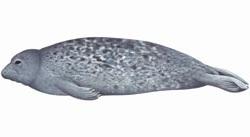Introduction
Bycatch
Many mammals are today endangered due to human activity. For marine mammals the main threat is often bycatch and even Odontocetes (toothed whales), that are known to use echolocation for spatial orientation as well as target detection and discrimination, are caught in fishing nets. Bycatch has recently been suggested to have caused the first extinction of a Cetecean species, the Yangtze River dolphin (Lipotes vexilifer).
Harbour porpoises

The Baltic Sea sub-population of Harbour porpoises (Phocoena phocoena) is critically endangered, with only about 500 animals today. It is suggested that the harbour porpoise get entangeled in the fishing nets due to their use of higher frequency, more narrow-band clicks than most Odontoceti species, which makes them fail to detect the nets in time.
Pingers
To adress this problem the EU adopted a regulation in 2004 that, inter alia, includes mandatory use of acoustic deterrent devices, so called pingers, on gillnets in some European waters, including the Baltic Sea, and for vessels larger than 12 m in length. Pingers emit ultrasounds pings with varying intervals and frequencies that deter porpoises and whales. Several pingers have been tested and used for a long time with results showing a significant and persisting reduction in bycatch of porpoises.
Grey seals

However, pinnipeds have been shown to use pingers as "dinner-bells" and thereby finding the nets more easily. Grey seals (Halichoerous grypus), with about 45.000 individuals in the Baltic Sea, have also been shown to locate pingers. They not only forage on the fish caught in the nets, they also scare away fish, wich reduces the catch, and furthermore damage the nets, causing considerable extra costs for the fishermen. Therefor fishermen are very reluctant to use pingers, especially in the Baltic Sea where there has been a long conflict between the fishermen and the seals due to the big population.
It is of great importance to solve this dinner-bell effect and reluctance to use pingers, to both decrease the bycatch of harbour porpoises as well as solving the fisherman-seal conflict. Since Phocinid seals have a lower upper hearing limit than harbour porpoises (ca. 60 kHz vs 150 kHz) it is possible to make pingers inaudible for seals.
In this study I therefor tested two pingers, one made to and one claimed to be inaudible for grey seals, on both wild grey seals and harbour porpoises.
Fish preference
A second objective of my study was to investigate fish preference in wild grey seals. Knowing the diet of a species can make it possible to understand its role in the ecosystem and find solutions and management procedures. Studies on grey seals fish preference in the Baltic Sea was done several years ago and mainly on animals caught in fishing gear. Since the fish populations have changed since then (the diet of seals are affected of what is available) and knowing the fish preference of seals not engaged in fishing gear could contribute new information I tested this as well. The fish species I tested were Herring (Clupea harengus), Perch (Perca fluviatillis), Flatfish (Platichtys flesus), Whitefish (Coregonus lavaretus) and Salmon (Salmo salar).
Responsible for this page:
Director of undergraduate studies Biology
Last updated:
06/04/18
